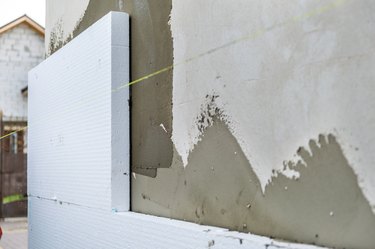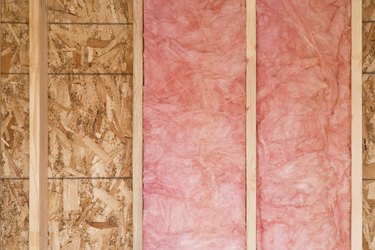
Styrofoam insulation and fiberglass insulation are two of the most common insulation materials. They are both reasonably affordable and widely available, and they can be easily installed by homeowners, but there are advantages and disadvantages to each material. When deciding which product to use in your home, consider which is better suited to your project.
What Is Styrofoam Insulation?
Video of the Day

Styrofoam insulation is one type of rigid foam insulation, which comes in large panels. Its technical name is EPS, for expanded polystyrene, and it's the same material used for foam coffee cups and inexpensive coolers. The most common panel size is 4 x 8 feet, and thicknesses range from 1/4 inch to 2 1/2 inches. The R-value, or how well a material slows the transfer of heat, of EPS is about R-4 per inch. The higher the R-value, the better the insulating performance.
Video of the Day
EPS foam insulation is highly resistant to moisture, making it a good option for damp areas, such as basements and crawlspaces, where other forms of insulation may be damaged by humidity or direct water contact. Rigid foam board does not expand or contract under extreme temperatures or degrade over time, but it can be damaged by direct sunlight.
EPS insulation is commonly applied directly to concrete or concrete block walls, such as foundation walls, and in other applications requiring a relatively thin, rigid material. It can also be used in below-grade or buried applications. In an existing home, which presumably has insulated wall and roof assemblies, EPS foam might be used to insulate between floor joists in an unfinished basement.
What Is Fiberglass Insulation?

Fiberglass is made from tiny glass fibers and is sold in precut batts and longer rolls as well as in loose-fill form for blow-in applications. The air pockets inside fiberglass insulation reduce heat transfer but also trap moisture, which can cause mold or mildew growth. This is why fiberglass should be avoided in areas with moisture or humidity.
Individual batts and rolls are typically anywhere from 3 1/2 to 12 inches thick and either 15 or 23 inches wide and are useful for placing in framed walls and ceilings where the framing members are usually spaced 16 or 24 inches apart. Rolls are usually between 24 and 32 feet long, while individual batts are usually 93 inches long.
Installing batts and rolls is fairly simple, but it is important to wear sufficient protective gear to keep skin and eyes safe from the itchy fiberglass fibers. Batts must be properly secured with six points of contact, and it is important to avoid compressing the fiberglass, or this reduces its insulating properties. It is also possible to install loose-fill fiberglass by renting a mechanical blower, but this process can be difficult for amateurs.
While rigid foam insulation tends to have a somewhat higher R-value per inch when compared to fiberglass's average R-value of 2.9 to 3.8 per inch of thickness, the greater thickness of fiberglass means it typically has higher R-values overall.
Which Is Right for You?
If you need something thin but want a higher R-value, EPS foam will give you more insulation per inch, but if space isn't an issue, fiberglass insulation can provide a higher R-value. If your installation area features a lot of curves, like a domed roof, fiberglass is a must since rigid foam cannot be bent. On the other hand, if you want something easy to install and you don't want to worry about compressing the materials or getting itchy fibers in your skin or eyes, then you'll probably want to choose rigid foam boards. Finally, due to fiberglass's issues with moisture, if you're installing in an area below grade that is regularly exposed to water or has a high humidity level, only work with rigid foam insulation.